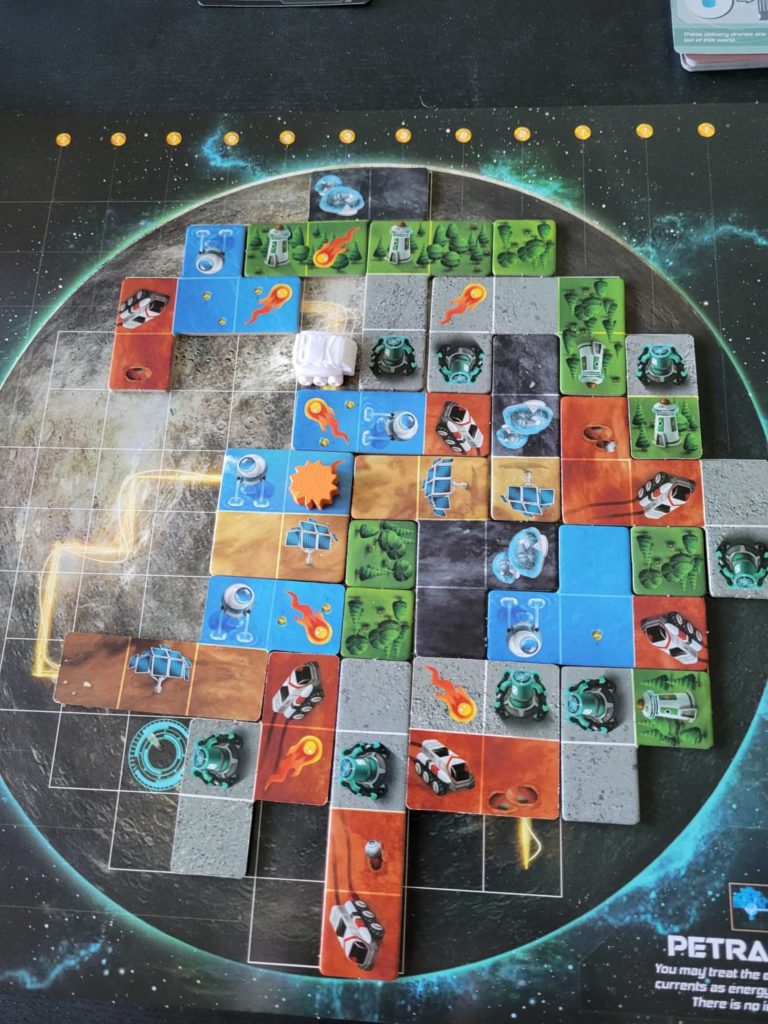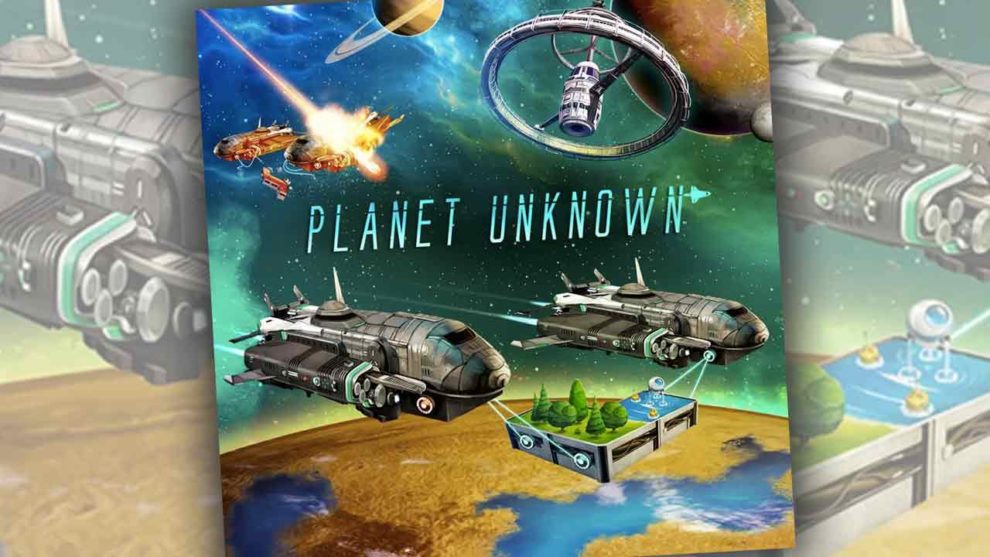Disclosure: Meeple Mountain received a free copy of this product in exchange for an honest, unbiased review. This review is not intended to be an endorsement.
Planet Unknown does what it says on the tin, and it also manages to sidestep some of the pitfalls of the polyomino-puzzle genre. The game also got me thinking about the lie of reasonably predictable play (more on that in a bit).
The premise of PU *snicker* is that you’ve all found a planet suitable for life, and you’re going to explore it and put tiles on it to develop it. You also have a little rover you need to drive around with and pick up doo-dads. Everyone has a planet mat and a player board with a series of tracks on it, both of which can be asymmetric if so desired. I recommend playing with the asymmetry from the jump, as it adds fun wrinkles to the overall experience.

Draft kings
PU promises simultaneous play, which it delivers. All of the puzzle pieces sit in a lazy susan that the first player rotates around until they have a selection of two tiles they like, and then everyone else picks one of the two tiles that’s in front of their triangular player marker. Players place their tiles, and then the first player cycles, so everyone gets a crack at a piece they need eventually.
Tile placement is breezy: place your first tile on the periphery of your planet map, and after that, every tile must be orthogonally adjacent to one other tile you’ve already placed. Each tile has two icons on it, each of which bumps you up on the corresponding track on your player board. There are a few rules exceptions, like water tiles that don’t do anything unless they’re placed on water on your map, and tiles that copy what is adjacent to them. Some tiles have meteorites that come with them, interfering with your endgame scoring if you don’t retrieve them with your rover(s).

Players start with some amount of rovers, and each time they move up the rover track, they drive their little car around orthogonally and pick up either life pods (points at endgame) or the meteorites (points for every set of 3 at endgame).
The different tracks are substantially different and allow players to pick a strategic direction. Civ lets you draft card powers from a limited supply, Water gives points and other track bumps, Biomass gives track bumps and 1×1 tiles, Rover moves your rover, and Tech gives you new and cool powers.
The game is played until either a pair of bins is run out or a player cannot legally place a drafted tile on their board. Players score their mats along a number of dimensions, and the game is over.
PU does what a lot of solitaire puzzlers rarely deliver–a light, easygoing experience where you can just enjoy the presence of other people while socketing pieces into a complex array. It’s well-machined, has a great sense of progression, and wraps up in an hour, maybe 90 minutes if you’ve got some thinkers.

Player interaction is for chumps
Now, the lie of reasonably predictive play. This is something that I see frequently with games that feature positive interaction. Where negative interaction is removing other players’ pieces or directly attacking them, positive interaction usually revolves around competitions where you grab a resource or a space someone needs before they get a chance, or draft a card that they need, or anything that hamstrings another player without directly punching them in the teeth.
A lot of games have positive interaction that I think is poorly designed or not particularly fun. I’ve never found the mechanism of “you took my spot and now I have to do something else” to be particularly compelling, and often the interactions and strategic landscapes of many modern board games result in a player doing something that accidentally hamstrings another player without them realizing that they’re doing this.
I call it the lie of reasonably predictable play because often people believe falsely that you can predict how someone can positively interact with you in a game, and often that’s just totally impossible, or grinds the game to a halt while players painstakingly consider every move.
I mention this because PU almost falls into this trap. It comes with cards that feature a small competition between you and the players to your left and right. They’re usually things like “Have more of icon X than your opponent” kind of things. This design choice feels a little bit lazy, and runs counter to the promise of the game. You do not want to have to call for turn order rules (which the game has) so you can micromanage a decision that is likely arbitrary. The tile drafting is very difficult to control. Luckily, all of the goal cards can be converted into private goals, and this solves the problem nicely.
I enjoyed my time with PU, thanks to its clean execution and lovely pacing. There’s quite a few rules clarifications for the asymmetric powers, which you can see summarized in this thread, which I recommend reading. Don’t bother with trying to make it a competitive event and you’ll have a good time.













Add Comment